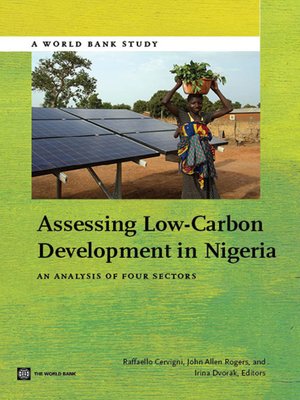Assessing Low-Carbon Development in Nigeria
ebook ∣ An Analysis of Four Sectors · World Bank Studies
By Raffaello Cervigni

Sign up to save your library
With an OverDrive account, you can save your favorite libraries for at-a-glance information about availability. Find out more about OverDrive accounts.
Find this title in Libby, the library reading app by OverDrive.



Search for a digital library with this title
Title found at these libraries:
| Library Name | Distance |
|---|---|
| Loading... |
The Federal Government of Nigeria has adopted Vision 20: 2020âan ambitious strategy to make Nigeria
the worldâs 20th largest economy by 2020. In the absence of policies to accompany economic growth in key
carbon-emitting sectors with a reduced carbon footprint, emission of greenhouse gases could more than
double in the next two decades. To evaluate how to achieve the objectives of Vision 20: 2020 with reduced carbon emissions, the Federal
Government of Nigeria and the World Bank undertook a multiyear program of analytical work. The summary
results of this program are contained in a separate book (published in the World Bankâs âDirections in Developmentâ ?
series) entitled Low-Carbon Development: Opportunities for Nigeria, which concludes that Nigeria can
achieve its development objectives, while stabilizing emissions at 2010 levels and providing domestic benefi ts
on the order of 2 percent of GDP. This volume is a collection of the background technical reports on the four sectors of inquiry: agriculture and
land use, oil and gas, power, and transport. It contains details on the data, methodology, and assumptions used
throughout the analysis. For agriculture and land use, the study team developed an agriculture production growth model, which
permits the evaluation of sector emissions in both a reference and a low-carbon scenario. The study fi nds that
low-carbon practices have signifi cant potential to make the sector more productive and more climate-resilient.
For the oil and gas sector, the analysis assesses the potential of accelerated phase-put of gas fl aring, reduction
of leakages, and increased energy effi ciency in the operation of facilities, to both reduce the sectorâs emission
and contribute to the industryâs net revenues and growth. The analysis of the power sector shows how the
country can expand power generation and broaden access to electricity while reducing associated emissions,
through renewable energy, energy effi ciency, and lower-carbon technologies in thermal power generation.
Finally, this analysis assesses the expected growth in CO2 emissions from on-road transport under a normal
business development scenario up to the year 2035, and it identifi es actions at national and local levels that
would reduce this growth, resulting in fuel economies, better air quality, and reduced congestion. Assessing Low-Carbon Development in Nigeria: An Analysis of Four Sectors outlines several actions that the
Nigerian government could undertake to facilitate the transition to a low-carbon economy.







